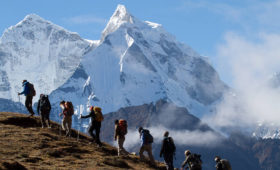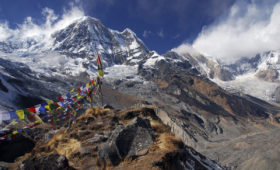Buongiorno, fellow adventurers and history buffs! Weary of the cobblestone streets of Rome and yearning for wide-open spaces and breathtaking vistas? Then cast your gaze eastward, towards the majestic Himalayas, the crown jewel of Asia. Nepal, the landlocked kingdom nestled within these mighty peaks, beckons with some of the world’s most incredible trekking adventures.
But before you lace up your hiking boots and book your flight, a crucial question arises: When is the best time to trek in Nepal? Fear not, intrepid explorers! This guide will navigate you through the seasons, helping you choose the perfect time to conquer your Himalayan dreams.
Nepal’s Seasons: A Tale of Two Monsoons
Unlike Italy’s well-defined seasons, Nepal’s climate is dominated by monsoons, creating a unique cycle that impacts trekking conditions. Here’s a breakdown of the four main seasons:
- Spring (March to May): Spring paints the Himalayas in vibrant hues as wildflowers burst into bloom. With pleasant daytime temperatures and mostly clear skies, it’s an idyllic time to trek. However, occasional spring showers can bring unpredictable weather changes.
- Summer (June to August): Monsoon season arrives, blanketing the Himalayas in lush greenery. While the vibrant landscapes are stunning, heavy rainfall and landslides can make trekking treacherous. Most high-altitude treks are best avoided during this time.
- Autumn (September to November): Considered the golden season of trekking in Nepal, autumn boasts clear skies, crisp air, and breathtaking mountain views. Temperatures are cooler, making for comfortable hiking conditions, especially at higher altitudes.
- Winter (December to February): Winter brings the least rainfall but also the coldest temperatures. High-altitude treks are challenging due to snow and ice. However, some lower-altitude trails remain accessible for those seeking a winter wonderland experience.
Choosing Your Ideal Season: A Balancing Act
The best time to trek in Nepal depends on your priorities. Here’s a breakdown to help you decide:
- For Pleasant Temperatures and Beautiful Blooms: Spring (March-May) offers a delightful escape from the Roman summer heat. However, be prepared for occasional rain showers.
- For Clear Skies and Panoramic Vistas: Autumn (September-November) is the undisputed champion. Dry weather and crisp air provide optimal conditions for capturing stunning Himalayan panoramas.
- For Fewer Crowds: Shoulder seasons (March-April and October-November) offer a good balance between decent weather and smaller crowds. However, be prepared for slightly higher chances of rain in spring and colder temperatures in autumn.
- For a Challenging Adventure: Experienced trekkers seeking a test of their endurance might consider winter (December-February) on lower-altitude trails. Be prepared for frigid temperatures and potential snow.
Beyond the Seasons: Factors to Consider
The ideal trekking season can also be influenced by specific factors:
- Specific Trek: Each trek in Nepal has its own microclimate. Research the specific weather patterns of your chosen trek before booking your trip.
- Altitude: Higher altitude treks are generally colder year-round. Consider acclimatization time regardless of the season.
- Personal Preferences: Do you prefer scorching sunshine or crisp mountain air? Are you comfortable with occasional rain showers? Knowing your preferences will help you choose the season that best suits your comfort level.
Festivals and Cultural Immersion:
Nepal’s vibrant culture adds another layer to your trekking experience. Consider these festivals when planning your trip:
- Dashain (September/October): The biggest festival in Nepal, Dashain coincides with the trekking peak season. Be prepared for potential crowds and higher prices.
- Tihar (November): The festival of lights, Tihar, offers a unique cultural experience, but might overlap with the tail end of the trekking season.
Planning Your Himalayan Adventure: A Practical Guide
Once you’ve chosen your ideal season, here are some practical tips to ensure a smooth trekking experience:
- Book Permits and Flights Well in Advance: Popular treks require permits, especially during peak season. Book your flights and permits well in advance to avoid disappointment.
- Choose a Reputable Trekking Company: A reliable trekking company can provide logistical support, experienced guides, and essential equipment rentals.
- Pack for All Weather Conditions: Nepal’s weather can be unpredictable. Pack layers that can be adjusted for changing temperatures and be sure to include rain gear.
- Acclimatize Properly: Altitude sickness is a serious concern. Plan your trek to allow for proper acclimatization, especially at higher altitudes.
Beyond the Trek: Exploring Nepal’s Treasures
While trekking is a highlight, Nepal offers much more.




